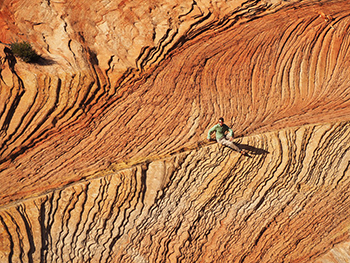
In this winning photo, “Movement of the ancient sand”,
Dr Matthew Huber, postdoctoral research fellow in the
Department of Geology at UFS, is scaling an outcrop
of sandstone (former sand dunes) in the Zion National
Park in the US.
Photo: Dr Elizaveta Kovaleva
Dr Elizaveta Kovaleva and Dr Matthew Huber, postdoctoral research fellows in the Department of Geology at the University of the Free State (UFS), attended the European Geosciences Union (EGU) General Assembly in Vienna, Austria in April 2017, where Dr Kovaleva was declared a winner of the EGU photo contest with a photograph entitled “Movement of the ancient sand”.
Submitting the winning photo
Each participant could submit up to three photos to participate in the contest before the conference. From all the photographs 10 were selected and displayed for the entire week at the assembly so participants could vote for their three favourite photos. At the end of the week three winners were selected. The prize winners received a free EGU book of their choice, free registration for next year’s EGU and an option to judge the photo competition next year. The photos will be printed on postcards next year, so all participants can send them wherever they want around the globe.
“The picture was taken in the Zion National Park in the US. Myself and Dr Huber were travelling around the western states, visiting national parks. The person in the picture is Dr Huber,” said Dr Kovaleva.
Dr Kovaleva was also invited to participate - as a recently published author - in a workshop, called: ”Publishing in EGU journals: Solid Earth and Earth Surface Dynamics – Meet the Editors”.
At the assembly, Dr Kovaleva attended sessions on Tectonics and Structural Geology as well as on Geochemistry, Mineralogy, Petrology and Volcanology. These sessions were especially interesting in the scope of her research and are directly related to it. “I am a metamorphic petrologist, and with my PhD, I essentially studied microstructures. At the moment, I am studying the Vredefort impact crater, which has experienced both metamorphism and deformation,” she said.
“The winning photos will be printed on postcards,
so all participants can send them wherever they
want around the globe”.
Building scientific connections
For both researchers, the assembly was an opportunity to meet former colleagues and professors from universities all over the world and shake hands with authors whose papers and work they were familiar with, but had never met in person.
“EGU is a perfect opportunity to build scientific connections and relationships, advertise your research and start new collaborations and projects,” said Dr Kovaleva.
The EGU General Assembly 2017 was a great success, with 4 849 oral, 11 312 poster, and 1 238 PICO presentations. Some 649 unique scientific sessions, together with 88 short courses and 322 side events, created an interesting programme. At the conference 14 496 scientists from 107 countries participated, of whom 53% were under the age of 35. Thirty one were from South Africa.